Garmin BlueChart Mobile & WiFi Adapter, hands-on #2
While my “hands-on # 1” enthusiasm for the BlueChart Mobile app was pretty clear, I’m not as bullish about Garmin’s Marine WiFi Adapter kit. But first the good news. All I had to do was plug the black Garmin Ethernet cable above into Gizmo’s test GPSMap 7212, make the other connections to the little black POE (power over Ethernet) box, and plug the results into a 12v socket {correction: Garmin is supplying 110 AC POE adapter, not 12v, see comments}. It didn’t really matter where I put the adapter itself as it has the WiFi horsepower to reach an iThing anywhere on boats larger than mine. And it all just worked. Well, almost…
When I first set up the adapter and then selected the new “garminmarine” hotspot on the iPad3, BlueChart Mobile could not see the NMEA 2000 GPS that’s networked to the 7212. While the problem was easily solved once Garmin tech support had me enable “NMEA 2000 Output Bridging”, it’s my understanding that some N2K data is never bridged onto Garmin’s Marine (Ethernet) Network and therefore getting values like depth and wind direction/speed to the app is not as easy as some might presume. Even if Garmin decides that’s a feature worth adding. And then there are the issues of cost and flexability.
It’s not hard to figure out that Garmin’s $200 WiFi Adapter is actually a Ubiquiti PicoStation M2-HP that you can pick up on on Amazon for $80. That’s going to gall some people, even when assured that Garmin’s version is specially set up (the default PicoStation won’t “just work”). But given Ubiquiti’s famed configurability and WiFi power, couldn’t the Garmin adapter connect to Gizmo’s own WiFi router so the iPad could also be getting marina and anchorage WiFi Internet via a Ubiquiti Bullet like the Rogue Wave or NautiCloud? Or couldn’t it even serve Internet to the boat Bullet-style when not being used with the Garmin network? Garmin’s answer was essentially “sorry, no and no”…
Frankly, I’m rather dim about the under pinnings of WiFi, but I’m definitely getting the impression that making it play with marine navigation networks is complicated, and I was glad to find ActiveCaptain’s Jeff Siegel discussing specific Garmin complications on TugNuts today. I’m also glad that Jeff is hoping to help folks set up their existing routers to make the connection between Garmin MFDs and BlueChart Mobile. But if that happens, let’s acknowledge that Garmin has every right to say “please don’t call us with support issues.” Let’s also acknowledge that Garmin has gone some extra distance just trying to make the app integrate with existing hardware. Furuno is doing neat things with MFD WiFi and so is Raymarine, but not in a backward compatible way, and while Navico GoFree can connect at least a MFD generation back, not all data tiers are supported.
So what can BCM and the WiFi Adapter do for you? At the moment, the screen above tells the whole story. Tapping those Export and Import buttons worked exactly as explained, though it did take me a moment to understand that I needed to poke under the big BCM steering wheel icon to actually display something like the entire Gizmo migration track recently posted. It was fun to use BCM to drill down on those many thousands of track points as in the Baltimore screen below. It conjures up the nice morning Leonard and I checked out BMC Harborview, where Trawler Fest was setting up, and then executed an Inner Harbor pirouette before settling into the marina I mentioned on Monday. The track also reminded me that when I left by myself a week later I didn’t fire up the 7212 until I got out in the channel. Tracks are fun but probably the main reason people will install the WiFi Adapter is routing…
BlueChart Mobile definitely has some sweet routing features, like the way its list view offers several quick sorting methods and thumbnail graphics of the routes themselves (as seen below). But the method of actually creating a route is different than it is on a Garmin touch MFD and I’m not sure I like the change…
Once I start a route on the 7212 I tap in the general vicinity of the next waypoint, then move my hand away and slide the chart around under the proposed waypoint until precision is achieved, and finally hit the Create Turn screen button. It’s quicker than it sounds and it demolishes the early presumption that touch screens aren’t good for route making because your finger gets in the way. (This is another subject that may deserve a whole entry as there are numerous solutions. The latest Raymarine displays, for instance, let you either tap create a waypoint or tap and hold to move your finger tip away from the spot and adjust it. I repeat: Touch screen charting is NOT one thing.)
At any rate, laying down waypoints in BCM is just a simple tapping process and I also find the icons a bit clunky, but they are easy to modify and it will also be easy for Garmin to modify the whole app as user responses come in. In conclusion, I caution people not to assume what the WiFi Adapter can do based on consumer electronics. It’s just a Garmin Network extender. I think Garmin can add more functionality to the BCM relationship, and almost undoubtedly will when it comes to the new MFDs with WiFi built in, but as the package stands I think some Garmin owners will respond “meh!” and others will find $200 a small price to pay for connecting their iThing to their large nav system investment.
One other thing: This whole exercise reminded me of Garmin’s HomePort Windows and Mac planning software and so I copied the 7212 data to an SD card and fired up HomePort on Gizmo’s PC. An auto update revealed that the software is even more refined than what I wrote about it in 2010, but just the basics are worth comparing to BCM. You get to use the Garmin charts you already own, there’s no extra expense to moving data back and forth, the track display can even include depth profiles, import of routes in third party formats is supported, and route-making with a mouse actually works quite well…if you’re willing to be so retro.


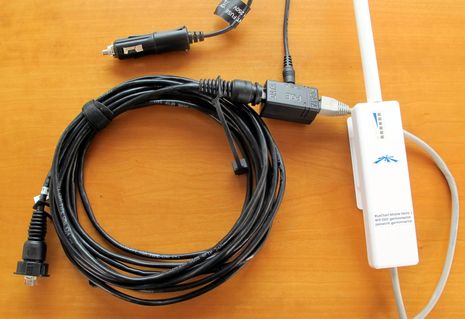
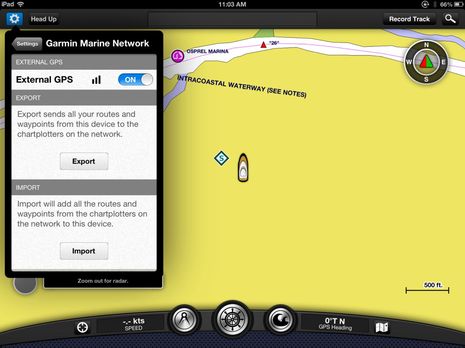

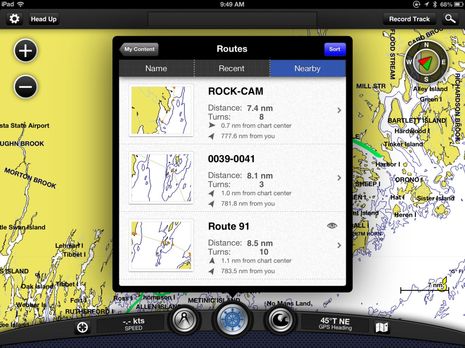
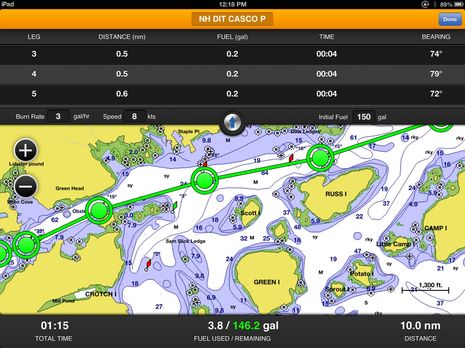
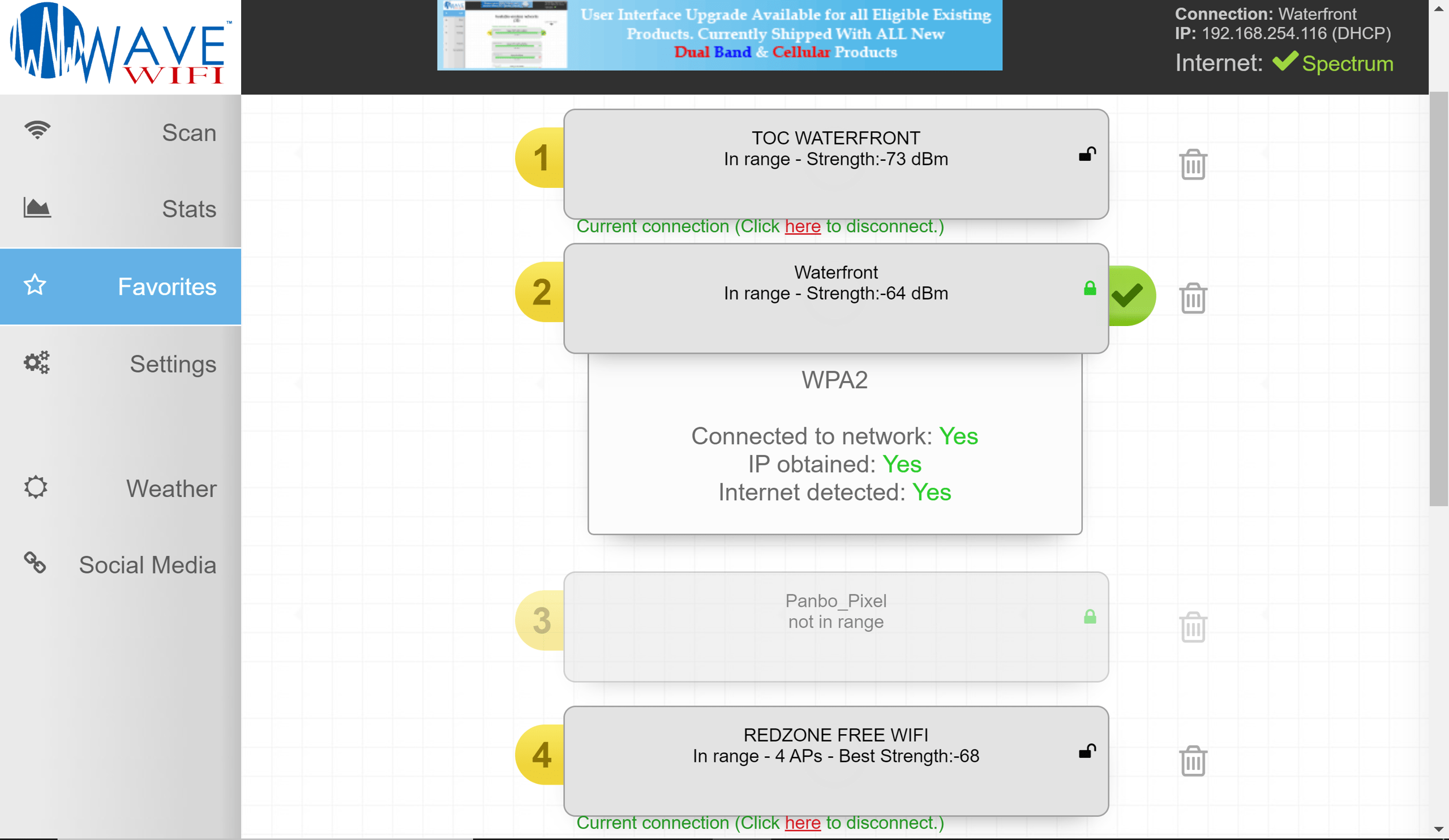


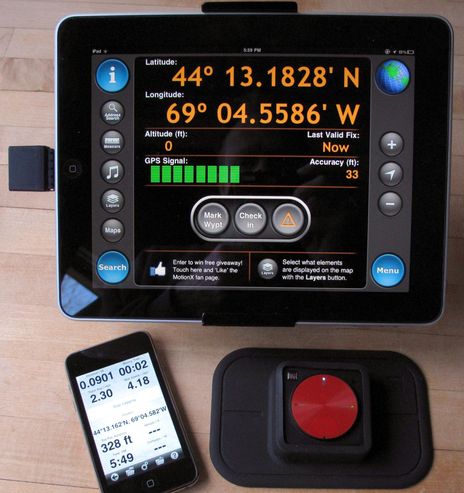







Ethernet networking, including WiFi, is not always 100% plug and play. DHCP etc have gotten us a long way, but sometimes it just won’t work.
For this reason it seems most manufacturers say “You have to do it our way” and do not support joining existing networks (either wired or wireless). Sad that. I could even live with “it will work with existing networks but then you won’t get any help from us regarding the network.”
Luckily some manufacturers do it that way. Vesper and Navico (Simrad/B&G/Lowrance) spring to my mind, but I’m probably forgetting some.
Ben, I think it is time for another big spreadsheet!
Thanks, Kees. According to Jeff’s TugNuts posts the Garmin system needs a fixed IP and the radar/sonar data can overwhelm a router. Given those issues what do think is possible with the PicoStation?
Concerning HomePort and “You get to use the Garmin charts you already own” there is one potential snag that I might bring to your readers attention. I have always used Americas vX BlueChart CD’s as my base map in MapSource and then HomePort. I owned the CD’s and it gave me something to work with if I didn’t feel like finding and installing the MFD’s SD card. I did not use the dated charts for anything but a base map, but why not I paid for them. You used to install the maps, go to the Garmin website, enter your customer number and it would unlock the maps. This no longer works. Garmin does not support BlueChart CD unlocking on their website any longer and the Chart unlock codes have been removed from your account data. I tried to get a work around through support but ended up with a “not happening” response. If you do not have a backup of your unlock codes to manually insert, than your bought and paid for BlueChart CD is a not very decorative coaster.
I think what Jeff said was that it would overwhelm “most normal routers without filtering”. I would love to test it on an ASUS Black Diamond (RT-N56U)! That’s with the new Russian firmware of course. You could bump the traffic up to the 5 Ghz band where they send gaming and media streaming traffic (it is dual band and yes most new iThingys have 5 Ghz I am told). It can do 600 Mbps which is 300 each for 2.5 and 5 Ghz. Would make a great cabin heater for you northern boaters as well!
At the Ft. Lauderdale boat show I asked several questions around this device. My first question was why this device and not the router I already have? The Garmin rep I spoke with said that they had tried to build instructions to use one’s own router/WiFi Hot Spot but that the instructions were many pages long.
I believe we can use our existing equipment but there are many questions I have around how to configure it properly.
I am getting out on a technical limb here, but I wonder if it wouldn’t be possible to set up a wi-fi to wi-fi bridge to connect a boat’s existing network with a Garmin network. (Or Raymarine, for the matter.)
Perhaps more realistically, perhaps the idea of another spreadsheet showing the manufacturers who support connecting to existing access points versus those who don’t.
For me, requiring multiple networks/access points–and switching back and forth–is not a nonstarter.
All these developments are interesting but not working perfect. Why doesn’t Garmin work with a n2k to wifi connector?
I was working with Garmin n2k network > Actisense nmea 0183 to 2000 > Digital Yacht wln10 . But this was à long road of problems. Not All The data was converted and with every update for the Actisense or DY new problems were there to solve.
So I Sold the Actisense and DY to wait for New and better solutions.
Hoping that Garmin or somone else will bring a good working solution for a good price.
As I can read here this is also not working well. Thinking that we have to wait longer…
Also one of the issues is that many solutions only allow one iThing to connect at once.
When I’m saling with friends or in à regatta, every crewmember wants to see The boatdata on huis iThing.
Although I’ve spent a whole career plugging one computer into another, I’ve become satiated. I still solder and use a multimeter, but now I appreciate most the devices that just work as soon as they come out of the box.
Some manufacturers seem unaware that time has rolled on. We can see that networking is via radio, either WiFi of Bluetooth, why can’t they? The cost of adding inter connectivity via Bluetooth is a tiny chip, and its now far less than buying in a selection of plugs and sockets and having them fitted, and the cables made up.
I am reminded of the end of decoration and embellishment in architecture. Those Baroque and Victorian carvers and gilders who competed to out-lavish and out-complicate each other were caught napping as the fashion changed to the minimal and streamlined.
I have boxes of redundant interconnects and special cables that once seemed to be vital to make one proprietary device have additional, but essential facility. Now I have a perfectly reliable set of iOS tablets of various sizes that have good performance, and can be applied to a variety of tasks including determining my location, steering the boat, monitoring the machinery, and communicating with the outside world.
We need fewer new low-volume and pricey gizmos that use hardware boxes to undertake tasks that are already better performed by easily reconfigurable iPads. In other words, manufacturers need to reduce their mechanical and electronic engineering staff, and vastly increase their programming skills.
It will be unpleasant for them, but it’s as though we’ve all moved into the age of the motor car, and they are still trying to invent a new form of harness for the horse.
Adrian at slingthehook.com figured how to tame Simrad radar and sonar in a conventional WiFi router, and maybe it will work for Garmin gear?
http://slingthehook.com/?p=5271
So I took a trip out to the boat today and tried out a basic wireless access point connected to the Garmin Network. I was able to get BlueChart iOS on my iPad talking to my Garmin 5212 very quickly. See the details here: https://sites.google.com/a/patmcqueen.com/pat-mcqueen-home/home/garminmarine
Thanks, Pat!
So, was your sounder working OK when networked to your router? Also, did you see the slingthehook.com post about turning off multicasting, apparently necessary when hooking a conventional router to a Navico system)?
Also, I don’t think you’ll see an IP address for your GPS because it’s not an Ethernet device. Its data is getting to 5212 via NMEA 2000 and then being bridged onto the Garmin Network.
Hi Ben! The sounder was working. It showed a depth – but the boat was on the hard. I ended up revising the web page. There were three IP addresses coming from Garmin. So that would be sounder, GPS, and Plotter.
I saw the Slinghook post and it made sense. Everything I did worked as I was on the hard and not moving. (Plus no radar) When I talked to the Garmin folks at the Ft. Lauderdale boat show my impress was that they were concerned about bandwidth and that is why some data is filtered.
My WireShark packet analysis skills are quite rusty so this is pretty slow going. It generally feels that Garmin is taking everything that is on N2K and repeating it on the Ethernet over UDP. Unfortunately the data is not just XML – but fortunately it is not encrypted.
As I think of the possibilities I would like to accomplish two things:
1) Have a single boat network that connects tablets, PCs, etc and can also connect to shore when in range. (3g/4g/Wifi)
2) Begin to use data from the Garmin devices on non Garmin devices. For example my iPad can clearly get GPS from the Garmin. Why can’t my laptop running PolarView?
Garmin has an amazing choice in-front of them. They need to decide on open vs. closed. I am sure some scared executives are saying closed; don’t share the data with any non-Garmin devices. That is a very short term view that will hurt Garmin in the long run. Having a strong ecosystem around your products makes the products stronger. If Garmin chooses to be open they can wipe out the competition. Homeport is Ok – But why not use every other PC based charting solution as part of the Garmin Network?
My eyes opened up to a brave new world. I updated the post and have included the raw packet capture for anyone whom knows WireShark! https://sites.google.com/a/patmcqueen.com/pat-mcqueen-home/home/garminmarine
Ben,
You were right about the GPS Receiver … The three devices I see after some analysis are:
172.16.3.0 GDS22 (Sounder)
172.16.6.0 GPSMAP 5212
172.16.7.0 5212 Data Server
The Data Server may be the bridge of NEMA 2000 data but I am not sure yet.
Pat
Thanks again, Pat. I share your enthusiasm about what’s possible but I also think we should be cautious about our expectations. I don’t know as much about Ethernet and WiFi as guys like you and Adrian (slingthehook.com) and I’m glad you’ve had some initial success with hooking standard routers to Garmin and Simrad marine networks, but my sense is that many of us may have difficulties.
For instance, I doubt that Garmin created this special version of the Ubiquiti PicoStation because they wanted to. I think they did it because they found that there were so many headaches to setting up various standard routers, let alone ones that are also connected to Internet via WiFi or cellular. Navico seems to be taking the same approach with its WiFi1 and Raymarine’s WiFi MFDs only do direct connections to mobile devices. Truly integrating MFD networks with boat LANs and WANs make take another generation of MFDs or at least their software.
Also note that Garmin may not, in fact, bridge all NMEA 2000 data onto Ethernet, or not yet at least. So I’ve heard. (But then again Garmin has some other stuff in the hopper that’s going to blow some minds!)
At any rate, the WiFi-to-MFD-network thing is going to get interesting, for sure, and I too hope that the manufacturers make third party app development possible. It seems like Navico is off to a good start with GoFree:
http://tinyurl.com/Panbo-Navico-GoFree
I’ve been looking at the Garmin site and the description says the marine wifi adapter comes with a110v POE injector, but in the article photo you show a POE with a 12 accessory plug. How / where do you obtain the 12v POE? Thanks in advance for your help!
That’s surprising, even a bit shocking! Everything in that top photo was loaned to me by Garmin and certainly seemed to comprise what they would sell as a “Marine WiFi Adapter Kit”. And I’m pretty sure that product sell page did not originally contain this note:
“Kit includes a household AC power-over-Ethernet (POE) adapter. If you are unable to use the included adapter on a boat, you must purchase a POE adapter that supplies 12–15 Vdc and 0.8 A. Additional items needed for installation are 2 shielded Category 5 (CAT5) Ethernet cables (not included).”
Which makes no sense. Why in the world would Garmin supply an AC POE adapter — two actually, given the European model — for a marine system that runs on 12v? Especially as the Ubiquity Picostation they’re sourcing runs on 12-15v DC and therefore all you need is a “passive” POE injector. That’s why the little black box seen at top is so small; there’s no electrical adaption going on inside it.
Unfortunately, it’s not easy to find both the passive POE injector and a proper 12v DC power cord as a kit. Or at least I can’t. I guess I’d get an inexpensive passive POE splitter (like this: http://goo.gl/9p5OC ) which also takes care of one of the two Ethernet cables Garmin wants you to buy. Then I’d either cut off the existing plug or (better) find a matching connector I could wire to a 1 amp 12v fuse. I run my Rogue Wave WiFi on a similar setup, but they supplied all the parts:
http://www.landandseawifi.com/products/wavewifi-rogue
At any rate, I’m really surprised that Garmin has made this so hard for customers. It’s not a good example of “The Power of Simple” and makes you wonder if they care about selling the WiFi adapter.
Ben,
Thanks for the reply. I contacted Garmin and they didn’t have a solution (although the support person indicated they were new to the job). I started looking at passive POEs, but one of the forums I visited cautioned about starter noise. I’m on a 21′ Mako cuddy cabin with an eTec outboard. My existing electronics (VHF radio, Garmin 4208 and eTec digital displays) come off the batteries, so I’m not ure if I need to be concerned about starter noise or not.
I will keep digging and will write back with what I find. In the meanwhile, I’d be interested to hear how others have worked around the 12v issue, or if Garmin has given any recommendations to others who read this post..
Thank you for your reply.
I’m not done yet. It bothers me that I reviewed a product that came with parts that are not delivered to customers. And I’ve never seen a marine POE WiFi device that didn’t come with a 12v injector. I don’t think that Garmin is being devious (just sloppy) because I’m pretty sure that they could ship a proper 12v kit for the same cost to them.
I will communicate these opinions to Kansas
Ben,
I appreciate your tenacity and will wait to see how you make out with Garmin before seeking out a passive PoE alternative.
During the winter I use Home Port(sp?) on my laptop to investigate new routes for the upcoming season. BCM on an iPad takes it to the next level as the iPad goes with me much more often than my laptop.
Following is Garmin’s answer about supplying an AC POE source, instead of 12v. I’m curious about what others think of this reasoning.
“So, I did some asking around and here’s what I found out for you. The electronics and parts provided for your review were for convenience purposes so that you wouldn’t have to spend too much time getting everything wired and could start using BlueChart Mobile as quickly as possible.
We expect that the types of vessels that this hardware will be used on primarily will be larger vessels that will most likely have 110V power on board.
For any vessels that do not, we would simply recommend that the customer works with his or her local marine supplier to source a reliable and ruggedized 110V inverter. This will ensure that that customer is provided with the most robust solution and, more importantly, the best possible experience.”
Has anyone made any further progress configuring your router to communicate with your Garmin, without all the clutter from the sounder and radar?
Ben,
I found an inexpensive passive POE injector on Ebay for $4.50 that fits the bill and can use standard cat5e cabling or Garmin cords without the locking ring;
http://www.ebay.com/itm/Passive-POE-injector-for-IP-Camera-VoIP-Phone-Netwrok-AP-device-12V-48V-/160844834899?pt=LH_DefaultDomain_0&hash=item2573196853
Ubiquiti tech rep says the picostation can run on 12-24VDC so it can be used with 24V house systems as well. Garmin includes the bulkhead mount in the kit for outdoor pico mounting but it isn’t required and you can run either a Garmin cable (crossover) to the POE and either type to the pico, I had some Ray HS lying around that fit the bill.
Main caution with a POE is to pay attention to item #4 in the destruction manual, The POE port MUST be connected to the picostation and not the Network expander or MFD or you may cook the MFD’s network port! Picture in the mannual is backwards but labeling on the device is correct.
Scratch the Raymarine HS network cables for the POE to Ubiquiti connection. Ray leaves pins 4,5,7,8 unpopulated in their connectors so no power will go to the Ubiquiti, sorry!
Bill – You can’t use the PicoStation on a 24 v system. 24 volt systems run with about 28 volt in operation – sometimes up to 29 volt. 10% overshot is usually fine – but 20% is borderline and you risk burning out the voltage regulator in the PicoStation.
For a product to be 12/24 volt compatible look for ratings saying 10-30 or 8-32 volt. That should be safe. MikroTik “Micro” routers usually run 8-30 volt and cost less than the PicoStation.
I would get a regulated 12v -> 12v power supply for the PicoStation. I have a few NanoStation’s and Rockets and they are NOT very voltage tolerant, especially if the they are used in a hot climate.
Why has Garmin made this so difficult? An OEM-ed WiFi AP at 2x+ the price, loaded with custom software, and an AC power supply?
Just tell us the generic configuration needed, we’ll figure it out on our own APs.
Looks like the garmin adapter is now available with a 7-10 day shipping timeline.
Gentlemen,I am interested in setting up my garmin 4212 MFD with BlueChart Mobile app and garmin adapter kit. I would like to view charts on mfd and sonar on a tablet/Ipad or switch them. Will I be able to operate the Tablet w/chart anywhere on the boat.How difficult is this to do,I am not great at electronics, I would appreciate any help or suggestions. Thanks, Ed
Hi Ed, The Garmin WiFi Adapter and BlueChart Mobile combination only let you share GPS, routes, and tracks at the moment. It may get more features in the future but currently your desire to share charts and sonar is not possible.
Has anyone tried out the new wifi adapter yet? I havent seen any recent discussions about it now that it is out and available.
Yeah I’ve been looking around for more info on them. There is an interesting TugNuts topic on the whole using your own router idea and it seems perfectly possible. I’ve got an old Belkin G router which I may plug in to the back of my 7012 and see what happens. I’m no WiFi wizz by any means but I think it’s worth a try. And if it works with that then it’s probably worth getting the Ubiquiti for $100 less than the Garmin branded one. Jeff from Active Captain has suggested on a few different forums that he hopes to pass on the details of how to set your own up, the fact that he has said this surely means these instructions exist and it is possible, though I understand Garmin’s reluctance to let people get away with not having to buy their product!
Ben, as you may well know I have been a big proponent of using 5GHz 802.11(a&n) for the access point in a vessel. Leave the 802.11(b&g) for ship to ship or ship to shore based communications. There is so little spectrum in the 2.4GHz WiFi band why pollute it by adding additional AP’s inside your own vessel?
Now that I am finally launched I will be experimenting with Garmin’s WiFi. Only I will be using my favorite in boat AP (a Ubiquiti Rocket M5)using the 5GHz bands.
The only reason one should be using a 2.4GHz AP inside the boat is if you use Skype phones or have older devices that don’t work in the 5GHz bands.
I can make the same argument about wireless cameras.
Keep the boats internal signalling to 802.11(a&n) and you will be happier with your boat’s 802.11(b&g) performance.
Bill
Having just re-read the TugNuts topic here: http://bit.ly/11N6QNK I have found this from Jeff at Active Captain. “From my understanding, all it needs is a static IP hardware block which a hardware firewall should be able to implement…. If I turn off my radar and sonar, my normal Netgear router will put my Garmin network on WiFi and allow routes, etc to move back and forth to BCM. But turn on the radar and it literally crashes the Netgear router because there’s so much data.”
I don’t have a sonar or radar since I just have an NMEA2k intelliducer hooked into the network. This should mean that a standard Picostation using a bit of knowledge from here: http://bit.ly/13wK6f7 setting the correct static IP address should allow me to transfer routes without too much hassle at all. I’ll try it with my Belkin router next week but I’ll have to use an inverter to run it off the battery since it is a 240V home job. O.
I set up the Belkin into the 7012 yesterday and it seems to work with no issues at all. The router is configured as I explained above and all I had to do was plug it in. Because I am a cheapskate and haven’t yet actually bought a map for the bcm app, it wouldn’t let me ex- or import routes but I could use the external gps once outport bridging was enabled. I am pretty confident now that a picostation will work, and I will be trying this in a few weeks time.
I made some progress and now have an iPad on the Internet and connecting to my Garmin 7215 all at the same time. (and not using the Garmin WiFi adapter) The configuration is pretty straight forward …
https://sites.google.com/a/patmcqueen.com/pat-mcqueen-home/home/garminmarine/success
Nicely done, Pat! I’m not sure I’m ready to try it myself quite yet, but you may have helped out a lot of users.
Nice job and great documentation as well. Has anyone tried this using a 5GHz PICO or Bullet5?
I’ll be trying it this weekend coming up.
Pat thanks for doing all the hard work!
Bill Lentz
MV;WIRELESS ONE
Mainship 40SB
Little Egg, NJ
So I have the 740 and a 4G Ipad with ATT. Initially wanted to connect the iPad and 740 just for route swapping. Having read this write up it looks like I would need a router with a LAN cable to the 740 and the iPad connected wirelessly (802.11) to the router. Anyone know of a way I could bridge the cellular connection from the iPad to the wifi router?
My point being it seems like I would either get route transfer, or live internet, but not both… without an external wifi source like Pat did, correct?
That’s correct, Pat, but you have additional problem. The 740 is not a Garmin Network device; the Ethernet port is only designed for use with a Garmin radar. I doubt that it can networked with a router, even Garmin’s own WiFi adapter. It’s not list as a compatible device: http://goo.gl/JerZcu
More on the Garmin WiFi Adapter Kit power supply:
“Kit includes a household AC power-over-Ethernet (POE) adapter. If you are unable to use the included adapter on a boat, you must purchase a POE adapter that supplies 12–15 Vdc and 0.8 A.”
Most AC-to-DC POE injectors I’ve seen have a wall wart that you can just cut off and wire the actual injector to 12v. But I guess the Ubiquity injector that Garmin ships is an all-in-one design so users who want to use 12v will have to find a passive injector like the one shown in the top photo.
I think that one like this will work, but would like assurance:
http://www.amazon.com/NEEWER%C2%AE-Power-Ethernet-Injector-Camera/dp/B00CWTS5BI
It happens that Panbo reader Brian Strong is installing a WiFi Kit right now in Camden (on his beautiful new Maine Cat P47 with a mix of Garmin 800 and Simrad systems), so I should get a chance to see what the shipping Kit actually includes and what he comes up with for a solution.
Thanks to Brian, I can confirm that Garmin is shipping their WiFi Adapter Kit with a Ubiquity all-in-one AC PoE injector that can not be modified for 12 volts. Meanwhile the power specs of this PicoM2-H model are:
Power Supply: 12V, 1A DC, Supply and injector included
Power Method: Passive Power over Ethernet (pairs 4,5+; 7,8 return)
Max Power Consumption: 8 Watts –
I’m pretty sure that the passive PoE injector linked to above will work fine, as would the type that’s been powering my various test Ubiquity Bullets for years and was supplied with the Rogue Wave kit you can see here:
https://panbo.com/archives/2013/03/gizmos_antenna_mast_2013_flir_rogue_wilson_more.html
I have managed to do 5,500 miles of the great loop while waiting for Garmin to come up with a simple plug and play solution. I’m still waiting.
Looks like Garmin is including a POE adapter that is both AC and DC compatible.
https://buy.garmin.com/en-US/US/prod129410.html#gallery-dialog
Anyone have any luck or experience connecting this wi-fi with another network?
…and bumped the price up another $50.
IMO the Navico GoFree WiFi-1 remains the more sensible design for 12v marine install/mount.
I lost the manual and I need the password to reconnect. Any help would be appreciated!
I connected my device and did all the steps correctly and it all works great! But I had to disconnect my wifi antennae and reconnect everything but I misplaced the manual with the password and now I am lost!
Please help!